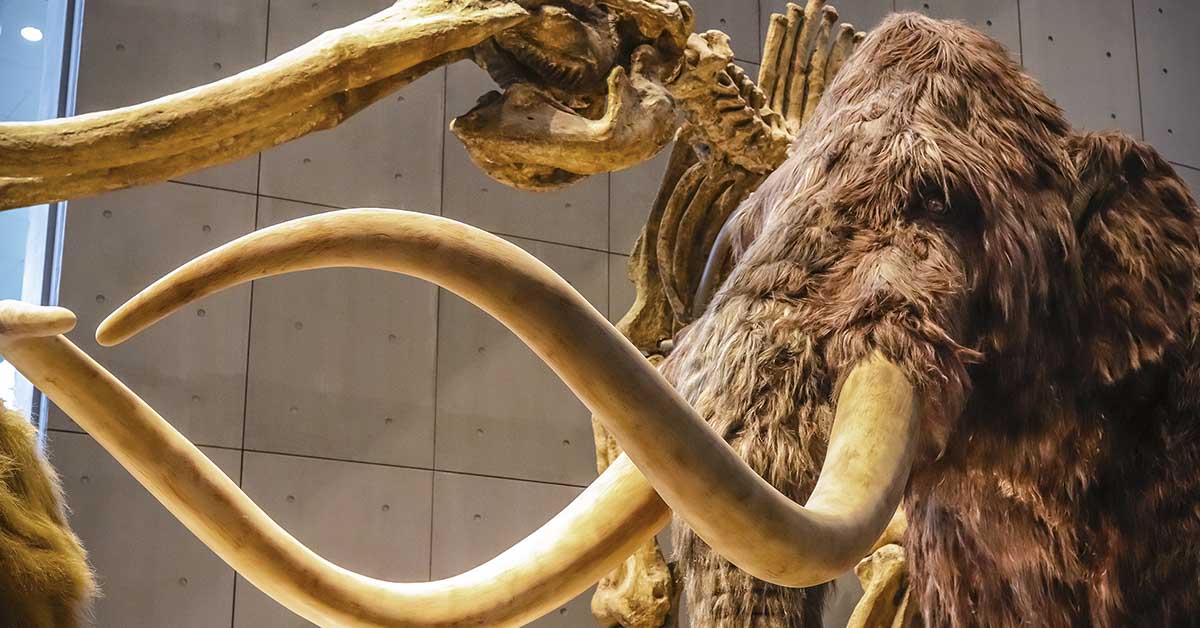A team of scientists is working to “reincarnate” the extinct woolly mammoth through genetic modifications. The Texas-based biotech company Colossal claims it will create a creature that closely resembles the prehistoric animal by 2027. They explained that their de-extinction goal is to make “a cold-resistant elephant with all of the core biological traits of the Woolly Mammoth. It will walk like a Woolly Mammoth, look like one, sound like one, but most importantly it will be able to inhabit the same ecosystem previously abandoned by the Mammoth’s extinction.” [1]
Scientists are “Resurrecting” the Woolly Mammoth
Harvard geneticist George Church and entrepreneur Ben Lamb founded and launched Colossal. Church is a pioneer of gene-editing technology called CRISPR. In this case, CRISPR allows the scientists to add cold-resistant genes into elephant DNA. At first, Church and his team examined key genetic differences between modern elephants and the woolly mammoth. Then they plan to insert their modified mammoth DNA into sections of the African elephant genome to make an embryo, which will grow in a recreated mammoth uterus for the almost-two-year gestation period.
Fortunately, the mammoth’s DNA is a 99.6% match to today’s Asian elephant, which shows the “resurrection” goal is more within reach that initially thought. “In the minds of many, this creature is gone forever,” the company says. “But not in the minds of our scientists, nor the labs of our company. We’re already in the process of the de-extinction of the Woolly Mammoth. Our teams have collected viable DNA samples and are editing the genes that will allow this wonderful megafauna to once again thunder through the Arctic.” [2]
Once the team succeeds in recreating the woolly mammoth, they plan to repopulate parts of the Arctic. They hope the animals’ dietary habits and migration patterns would help balance and strengthen the environment. As of now, there is a danger of Arctic wildlife taking up too much land, which can prevent frost from penetrating the earth. This permafrost is key to maintaining the carbon frozen underground, which has been slowly thawing and accelerating climate change. A herd of mammoths could help lower the grasslands and allow the frost to freeze deeper into the soil.
As Colossal’s website explained, “With cold-tolerant elephant mammoth hybrids grazing the grasslands and roaming comfortably during the winters, they scrape away layers of snow, so that the cold air can reach the soil. This also allows grasslands to thrive and since they’re lighter than forestry, the snow won’t melt as quickly. Making way for another benefit – a surface that reflects the Sun’s radiation.”
Even though we could, does that mean we should?
However, as this project progresses, it will raise ethical dilemmas on reintroducing and handling the newly reborn species. Some scientists ask if resurrecting extinct animals should be done at all, especially when there is limited knowledge about their habits and behavior.
Even now, critics say that there’s no proof mammoths would help the environment and the team’s time and resources would be better spent on more effective and proven endeavors. “There’s absolutely nothing that says that putting mammoths out there will have any, any effect on climate change whatsoever,” says Love Dalén, a paleogeneticist at the Centre for Palaeogenetics in Stockholm, Sweden. [3]
Some researchers argue that it’s more important to conserve the species that are going extinct today. The same “resurrection” technology could help these species survive, particularly those with a small gene pool like the white rhinoceros.
Although the researchers believe woolly mammoths could help the environment, they could also disrupt it. The Arctic could have shifted dramatically from the Arctic the original mammoths lived in. Some of their plants and food sources have also gone extinct, so they may not have enough to eat, so it’s uncertain if they could still survive in this environment. Plus, the other species living in the Arctic need consideration. How would they respond to the new creatures? How will they be affected?
Meanwhile, Michael Archer, a paleontologist at the University of New South Wales in Sydney, Australia, disagrees. “I think it would be unethical not to do it. I think the ethical issue here was the impropriety of humans making these animals extinct in the first place. It’s not about playing God, this is about playing smart human by undoing what we did.” [4]
Keep Reading: De-Extinction: Could the Ressurection of Extinct Species Be First Step to Jurassic Park Coming True?
Sources
- “Are Scientists Attempting to ‘Reincarnate’ the Woolly Mammoth By 2027?” Snopes. Alex Kasprak. February 1, 2023.
- “Scientists Are Reincarnating the Woolly Mammoth to Return in 4 Years.” Popular Mechanics. Tim Newcomb. January 30, 2023
- “These Scientists Plan to Fully Resurrect a Woolly Mammoth Within the Decade.” Smithsonian Magazine. Corryn Wetzel. September 14, 2021
- “How extinct animals could be brought back from the dead.” BBC. Jasmin Fox-Skelly. January 16, 2023

